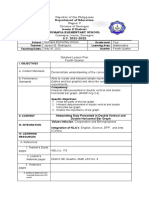quiz_interpret statistical graphs.
Uploaded by
KAHEARTBEAT TVquiz_interpret statistical graphs.
Uploaded by
KAHEARTBEAT TVSubject: MATHEMATICS B) The highest individual values
Grade Level: Grade 7 C) Patterns and differences in trends
Topic: Interpret Statistical Graphs D) The average of both data sets
Question 8: What does a scatter plot typically show?
Questions Section:
A) The relationship between two quantitative variables
Question 1: What does a bar graph primarily display?
B) The frequency of categorical data
A) Relationships between two variables
C) The distribution of data points
B) Frequency of categories
D) The total of different categories
C) Changes over time
Question 9: If a line graph shows a plateau, what does
D) Parts of a whole that indicate?
Question 2: In a pie chart, what does each slice A) Rapid increase in values
represent?
B) Steady values over time
A) The total number of items
C) Decreasing values
B) A percentage of the whole
D) Fluctuating values
C) The average of the data
Question 10: Why is it important to consider the scale of
D) A specific data point a graph when interpreting it?
Question 3: When interpreting a line graph, what does A) It affects the size of the graph
the slope of the line indicate?
B) It determines the colors used
A) The total amount of data
C) It can influence the perception of the data
B) The rate of change
D) It is not important
C) The average value
D) The highest point
Question 4: Which of the following best describes a
histogram?
A) A graph that shows parts of a whole
B) A bar graph with equal intervals on the x-axis
C) A line graph showing trends over time
D) A scatter plot of individual data points
Question 5: If a graph shows an upward trend, what can
we infer about the data?
A) The values are decreasing
B) The values are constant
C) The values are increasing
D) The values are random
Question 6: What is the primary use of a box plot?
A) To show frequency distribution
B) To identify the median and quartiles
C) To display individual data points
D) To compare two sets of data
Question 7: When comparing two different sets of data
on the same graph, what should you look for?
A) The total number of data points
Answer Key Section: Rationale: A plateau in a line graph indicates that the
values are steady over time, with no significant increase
Question 1: What does a bar graph primarily display? or decrease.
Answer: B Question 10: Why is it important to consider the scale of
a graph when interpreting it?
Rationale: A bar graph is used to show the frequency of
categories, making it easier to compare different groups. Answer: C
Question 2: In a pie chart, what does each slice Rationale: The scale of a graph can influence the
represent? perception of the data, potentially exaggerating or
minimizing trends and differences.
Answer: B
Rationale: Each slice of a pie chart represents a
percentage of the whole, allowing for easy comparison
of parts to a total.
Question 3: When interpreting a line graph, what does
the slope of the line indicate?
Answer: B
Rationale: The slope of the line in a line graph indicates
the rate of change, showing how one variable changes
in relation to another.
Question 4: Which of the following best describes a
histogram?
Answer: B
Rationale: A histogram is a bar graph that displays the
frequency distribution of numerical data with equal
intervals on the x-axis.
Question 5: If a graph shows an upward trend, what can
we infer about the data?
Answer: C
Rationale: An upward trend indicates that the values are
increasing over time, suggesting growth or improvement.
Question 6: What is the primary use of a box plot?
Answer: B
Rationale: A box plot is used to identify the median,
quartiles, and potential outliers in a data set, providing a
summary of the distribution.
Question 7: When comparing two different sets of data
on the same graph, what should you look for?
Answer: C
Rationale: It is important to look for patterns and
differences in trends to understand how the two data
sets relate to each other.
Question 8: What does a scatter plot typically show?
Answer: A
Rationale: A scatter plot displays the relationship
between two quantitative variables, helping to identify
correlations.
Question 9: If a line graph shows a plateau, what does
that indicate?
Answer: B
You might also like
- quiz_use appropriate graphs to represent organized data_ pie graph, bar graph, line graph, and stem-and-leaf plot.No ratings yetquiz_use appropriate graphs to represent organized data_ pie graph, bar graph, line graph, and stem-and-leaf plot.2 pages
- quiz_ data collection and sampling techniques, and the presentation of data in appropriate tables and graphsNo ratings yetquiz_ data collection and sampling techniques, and the presentation of data in appropriate tables and graphs2 pages
- Seeing Through Statistics 4th Edition Utts Test Bank pdf download100% (1)Seeing Through Statistics 4th Edition Utts Test Bank pdf download50 pages
- MCQs_AUS_G4_16.Data and Graphs_6.Choose the best graph typeNo ratings yetMCQs_AUS_G4_16.Data and Graphs_6.Choose the best graph type34 pages
- quiz_organize statistical data in a frequency distribution table.No ratings yetquiz_organize statistical data in a frequency distribution table.2 pages
- Unit 4: An Overview On The Analysis and Interpretation of Assessment ResultsNo ratings yetUnit 4: An Overview On The Analysis and Interpretation of Assessment Results18 pages
- Exploring Microsoft Office 2010 Volume 1 2nd Edition Grauer Test Bank 1100% (55)Exploring Microsoft Office 2010 Volume 1 2nd Edition Grauer Test Bank 136 pages
- Exploring Microsoft Office 2010 Volume 1 2nd Edition Grauer Test Bankinstant download100% (3)Exploring Microsoft Office 2010 Volume 1 2nd Edition Grauer Test Bankinstant download52 pages
- Complete Download of Exploring Microsoft Office 2010 Volume 1 2nd Edition Grauer Test Bank Full Chapters in PDF DOCX100% (14)Complete Download of Exploring Microsoft Office 2010 Volume 1 2nd Edition Grauer Test Bank Full Chapters in PDF DOCX50 pages
- Sampaga High School 4 Quarterly Examination in Mathematics 7100% (3)Sampaga High School 4 Quarterly Examination in Mathematics 74 pages
- Exploring Microsoft Office 2010 Volume 1 2nd Edition Grauer Test Bank instant download100% (2)Exploring Microsoft Office 2010 Volume 1 2nd Edition Grauer Test Bank instant download55 pages
- Class-Xi ECONOMICS (030) ANNUAL EXAM (2020-21) : General Instructions100% (1)Class-Xi ECONOMICS (030) ANNUAL EXAM (2020-21) : General Instructions8 pages
- Making Science Graphs and Interpreting Data DoneNo ratings yetMaking Science Graphs and Interpreting Data Done6 pages
- (Shared) Data Visualisation(Quiz-1 ,Jan-24 Term) (1)No ratings yet(Shared) Data Visualisation(Quiz-1 ,Jan-24 Term) (1)12 pages
- Exploring Microsoft Office 2010 Volume 1 2nd Edition Grauer Test Bank - PDF Version Is Available For Instant Access100% (3)Exploring Microsoft Office 2010 Volume 1 2nd Edition Grauer Test Bank - PDF Version Is Available For Instant Access49 pages
- Immediate download Exploring Microsoft Office 2010 Volume 1 2nd Edition Grauer Test Bank all chapters100% (3)Immediate download Exploring Microsoft Office 2010 Volume 1 2nd Edition Grauer Test Bank all chapters52 pages
- Exploring Microsoft Office 2010 Volume 1 2nd Edition Grauer Test Bank - Download The Complete Set In PDF DOCX Format100% (4)Exploring Microsoft Office 2010 Volume 1 2nd Edition Grauer Test Bank - Download The Complete Set In PDF DOCX Format50 pages
- Syllabus For MSC Big Data Analytics Entrance ExamNo ratings yetSyllabus For MSC Big Data Analytics Entrance Exam8 pages
- Exploring Microsoft Office 2010 Volume 1 2nd Edition Grauer Test Bankinstant download100% (1)Exploring Microsoft Office 2010 Volume 1 2nd Edition Grauer Test Bankinstant download61 pages
- Exploring Microsoft Office 2010 Volume 1 2nd Edition Grauer Test Bank - Download Now For An Unlimited Reading Experience100% (5)Exploring Microsoft Office 2010 Volume 1 2nd Edition Grauer Test Bank - Download Now For An Unlimited Reading Experience42 pages
- 1696603448-MDM4U - Unit 2 Statistical AnalysisNo ratings yet1696603448-MDM4U - Unit 2 Statistical Analysis9 pages
- Making Science Graphs and Interpreting Data DoneNo ratings yetMaking Science Graphs and Interpreting Data Done6 pages
- Changing Minds Changing Tools: From Learning Theory to Language Acquisition to Language ChangeFrom EverandChanging Minds Changing Tools: From Learning Theory to Language Acquisition to Language ChangeNo ratings yet
- Cfe M 215 Second Level Numeracy and Mathematics Assessment - Information Handling Data and Analysis - Ver - 16No ratings yetCfe M 215 Second Level Numeracy and Mathematics Assessment - Information Handling Data and Analysis - Ver - 1610 pages
- CSEC Maths 2017 January Past Paper SolutionsNo ratings yetCSEC Maths 2017 January Past Paper Solutions47 pages
- Hs1201-Professional English Class Notes Unit-I Part-A Purpose StatementsNo ratings yetHs1201-Professional English Class Notes Unit-I Part-A Purpose Statements61 pages
- Displaying Your Findings A Practical Guide For Creating Figures Posters and Presentations 6th Edition Adelheid A.M. Nicol Ebook All Chapters PDF100% (14)Displaying Your Findings A Practical Guide For Creating Figures Posters and Presentations 6th Edition Adelheid A.M. Nicol Ebook All Chapters PDF70 pages
- 02-Organizing, Presenting, and Describing DataNo ratings yet02-Organizing, Presenting, and Describing Data11 pages
- ST - Thomas Technical High School: School Based Assessment (Sba) Project 2023 - 2023No ratings yetST - Thomas Technical High School: School Based Assessment (Sba) Project 2023 - 20235 pages
- Lecture 4 5 CH 12 Writing Reports and ProposalsNo ratings yetLecture 4 5 CH 12 Writing Reports and Proposals114 pages
- 230 Fundamental Spreadsheet Applications R 2014No ratings yet230 Fundamental Spreadsheet Applications R 20145 pages
- Describing Data:: Frequency Tables, Frequency Distributions, and Graphic PresentationNo ratings yetDescribing Data:: Frequency Tables, Frequency Distributions, and Graphic Presentation35 pages

























































































